In the opening remarks of his article on page 38, Daniel Keim tells us that one million terabytes (or one exabyte) of data are now generated globally each year, and 99.9% of it is digital. It’s clear the mammoth mountains of data we’ve discussed in these pages for so many years have reached Everestian proportions, and navigating through and pulling information from them is more challenging than ever.
But these challenges are being met, and much of the credit goes to new technologies that allow far more effective ways of mining, representing, and visualizing information. This issue includes a select group of articles exploring many of the latest tools and techniques in information visualization, illustrating how critical the "visual" factor is when comprehending text. Collecting what you need is only the first step. Information visualization interfaces can take that collection and display it to your specification.
Keim focuses on the inventiveness of visual data exploration, contending this technique has great potential for revealing valuable patterns in data. He details the many potential applications of visualization technology that will likely occur in the next two to five years, and predicts this power should be available on desktop machines in the near future.
Stephen G. Eick explores how users, managers, and executives alike can use information visualization technology to trace the online activities of Web site visitors. This kind of information is priceless for assessing trends and patterns. It not only helps site owners build stronger online architectures and better navigational tools, but guides visitors through the site by understanding their interests for being there.
Many lessons can be learned about presenting information in a visually effective manner by considering the art of storytelling. Nahum Gershon and Ward Page examine the new media and genres now being used to convey information in a story-like manner.
And Mintzer et al. offer a fascinating account of building the Hermitage Museum’s new Web site—a project that brought together experts from around the world to capture the art and test the artistry of blending masterpieces and masterful technologies. The result is a multiaward-winning digital museum boasting more than 200,000 hits per day.
We hope you find their stories and experiences paint an illuminating picture of the state of the visual in information technology.
Diane Crawford,
Editor



Join the Discussion (0)
Become a Member or Sign In to Post a Comment